
Lauraceae, or the laurels, is a plant family that includes the true laurel and its closest relatives. This family comprises about 2850 known species in about 45 genera worldwide. They are dicotyledons, and occur mainly in warm temperate and tropical regions, especially Southeast Asia and South America. Many are aromatic evergreen trees or shrubs, but some, such as Sassafras, are deciduous, or include both deciduous and evergreen trees and shrubs, especially in tropical and temperate climates. The genus Cassytha is unique in the Lauraceae in that its members are parasitic vines. Most laurels are highly poisonous.

The Sierra Madre del Sur is a mountain range in southern Mexico, extending 1,000 kilometres (620 mi) from southern Michoacán east through Guerrero, to the Isthmus of Tehuantepec in eastern Oaxaca.
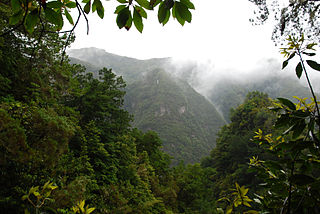
Laurel forest, also called laurisilva or laurissilva, is a type of subtropical forest found in areas with high humidity and relatively stable, mild temperatures. The forest is characterized by broadleaf tree species with evergreen, glossy and elongated leaves, known as "laurophyll" or "lauroid". Plants from the laurel family (Lauraceae) may or may not be present, depending on the location.

Ocotea is a genus of flowering plants belonging to the family Lauraceae. Many are evergreen trees with lauroid leaves.

Ostrya virginiana, the American hophornbeam, is a species of Ostrya native to eastern North America, from Nova Scotia west to southern Manitoba and eastern Wyoming, southeast to northern Florida and southwest to eastern Texas. Populations from Mexico and Central America are also regarded as the same species, although some authors prefer to separate them as a distinct species, Ostrya guatemalensis. Other names include eastern hophornbeam, hardhack, ironwood, and leverwood.

Abies guatemalensis, the Guatemalan fir or pinabete, is an evergreen tree native to Central America and is the southernmost member of the genus Abies being spread to the south lower than 14° N. Its range is from southern Mexico in the north to Honduras and El Salvador in the south. It is a warm-loving and moisture-loving tree of the tropical mountain coniferous and mixed cloud forests of these countries. The Guatemalan fir is an almost completely non-frost-resistant tree. Due to logging and loss of habitat, the tree is considered threatened and is protected in CITES Appendix I.
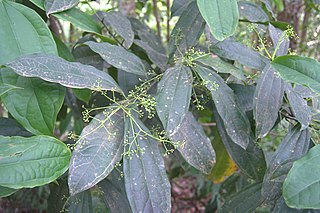
Aiouea is a genus of shrubs and trees in the family Lauraceae. It is native to tropical forests and montane forests of North and South America. The name is a curiosity because it consists entirely of vowels.

Beilschmiedia is a genus of trees and shrubs in family Lauraceae. Most of its species grow in tropical climates, but a few of them are native to temperate regions, and they are widespread in tropical Asia, Africa, Madagascar, Australia, New Zealand, North America, Central America, the Caribbean, and South America. The best-known species to gardeners in temperate areas are B. berteroana and B. miersii because of their frost tolerance. Seeds of B. bancroftii were used as a source of food by Australian Aborigines. Timbers of some species are very valuable.
Magnolia schiedeana is a species of flowering plant in the family Magnoliaceae. It is endemic to Mexico, where it occurs along the slopes of the Gulf of Mexico.

Quercus martinezii is a species of oak found in southwestern and central Mexico. It has been found in Nayarit, Jalisco, Michoacán, Guerrero, and Oaxaca states. It is placed in Quercus section Quercus.

Quercus uxoris is an uncommon species of oak.
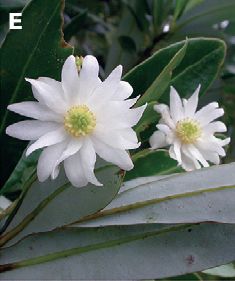
Drimys granadensis is a broadleaf evergreen tree of family Winteraceae. it is native to tropical montane forests from Peru to southern Mexico.
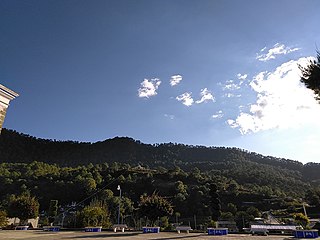
The Sierra Madre del Sur pine–oak forests is a subtropical coniferous forest ecoregion in the Sierra Madre del Sur mountain range of southern Mexico.
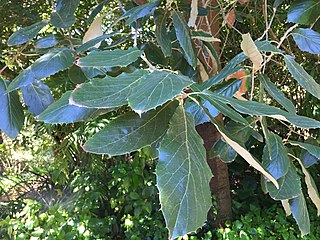
Quercus calophylla is a Mesoamerican species of oak tree. It is native to mountain forests of central and southern Mexico, Guatemala, and El Salvador. It has incorrectly been known as Quercus candicans.

Quercus elliptica is a Mesoamerican species of oak tree. It is widespread across central and southern Mexico and Central America from Sinaloa and Hidalgo south as far as Nicaragua. It is classified in Quercus sect. Lobatae.
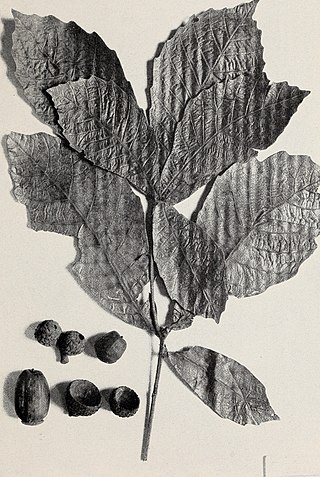
Quercus oocarpa is a Mesoamerican species of oak.
Quercus affinis is a species of oak native only to Mexico, mostly to the Sierra Madre Oriental pine-oak forests.
Carpinus tropicalis is a species of tree native to central and southern Mexico, Guatemala, El Salvador, Honduras, and Nicaragua.
Quercus nixoniana is an endangered species of oak tree native to southern Mexico. It is found in humid mountain forests of southwestern Mexico, in the states of Jalisco, Guerrero, and Oaxaca.















